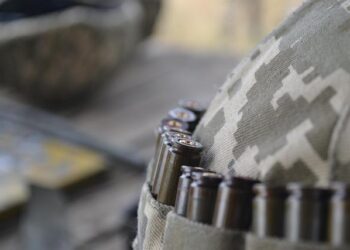Title: Analyzing the Latest Developments in the Russian Offensive campaign: A Thorough Assessment for March 11, 2025
In the evolving landscape of global security, the ongoing conflict in Ukraine continues to capture international attention, prompting critical assessments of military strategies and conflict dynamics. The institute for the Study of War (ISW) has released its latest report on the russian offensive campaign, dated March 11, 2025, shedding light on the current state of affairs on the battlefield and the implications for regional stability. This comprehensive analysis delves into recent military operations,tactical shifts,and the broader geopolitical context that shapes Russia’s strategic objectives. As both sides grapple with the complexities of warfare and its associated humanitarian crises, understanding the nuances of these developments remains essential for policymakers, analysts, and the public alike. This article will summarize key findings from the ISW report, offering insights into the current trajectory of the conflict and its potential ramifications for Ukraine and beyond.
Analysis of Recent Military Strategies in the Ukrainian Conflict

The current landscape of military strategies in the Ukrainian conflict has undergone notable evolution, influenced by both internal dynamics and external pressures. Key observations from the recent offensive campaigns highlight the adaptable nature of Russian military tactics, reflecting a shift towards more hybrid warfare approaches. The integration of conventional forces with cyber capabilities and informational operations has enabled Russia to exploit vulnerabilities in Ukrainian defenses. This adaptability is characterized by:
- Increased use of drones: Both reconnaissance and combat drones are being deployed for targeted strikes and real-time intelligence gathering.
- Networking systems: Enhanced interaction between units facilitates coordinated strikes and maneuver warfare.
- Misinformation campaigns: Psychological operations targeting civilian morale and military cohesion are being utilized effectively.
Conversely, the Ukrainian response has been marked by resilience and innovation, employing a mix of conventional and unconventional tactics to counter the Russian advances. Noteworthy strategies include:
- Decentralized command: Allowing unit leaders more autonomy in decision-making has improved responsiveness on the battlefield.
- Integrated defense systems: Enhancements in air defense mechanisms have been effective in minimizing the impact of aerial assaults.
- International partnerships: Collaborations with NATO nations have bolstered Ukraine’s military capabilities through training and technology support.
As both sides continue to evolve their military strategies, the outcome remains uncertain, with shifting fronts and continuous adjustments fueling the ongoing conflict.
Impact of Resource Allocation on Russian Offensive Capabilities

The allocation of resources within the Russian military significantly influences its operational capabilities, particularly in offensive campaigns. As evidenced by recent assessments, strategic distribution of personnel, technology, and logistics plays a critical role in shaping the effectiveness of military operations. Key areas where resource allocation affects readiness and execution include:
- Personnel Deployment: Effective troop positioning maximizes combat readiness.
- Technological Investment: Upgrades in weaponry and surveillance enhance operational power.
- Logistical Support: A well-managed supply chain enables sustained military action.
Moreover, the prioritization of specific military units and their corresponding funding often reveals the Kremlin’s strategic intentions.For instance,increased funding towards elite units like the Special forces suggests a focus on rapid-response capabilities and unconventional warfare tactics. The following table illustrates the current budget focus within various divisions:
| Military Division | Budget Allocation (%) | Operational Focus |
|---|---|---|
| Ground Forces | 40% | Conventional Warfare |
| Naval Forces | 30% | Maritime Operations |
| Air Force | 20% | Air Superiority |
| Special Operations | 10% | Asymmetric Warfare |
As the conflict evolves, understanding the dynamics of resource allocation not only uncovers the immediate military capabilities of Russia but also provides insights into future strategic intentions, making it a focal point of ongoing analysis and debate within military circles.
Civilian Infrastructure Under threat: Assessing the Humanitarian Crisis

The ongoing offensive operations have increasingly targeted civilian infrastructure, exacerbating the humanitarian crisis faced by millions. Major cities are experiencing widespread devastation, resulting in significant disruptions to essential services such as water supply, electricity, and healthcare. The systemic destruction of these infrastructures has lead to dire consequences for civilians, including:
- Inaccessibility to clean water: Attacks on water treatment facilities have left communities vulnerable to waterborne diseases.
- Healthcare collapse: Strikes on hospitals and healthcare centers hinder medical access for the wounded and ill.
- Displacement of populations: With residences damaged, many are forced to seek refuge in overcrowded shelters or flee the region.
This deliberate targeting raises serious concerns regarding compliance with international humanitarian law. The scale of destruction has prompted numerous organizations to call for immediate action, including:
- Increased humanitarian aid: organizations are urging international bodies to expedite aid delivery to besieged areas.
- Protection of civilians: Advocacy for stronger measures to safeguard non-combatants from armed conflict.
- Monitoring and accountability: Calls for establishing mechanisms to investigate war crimes and ensure accountability for those responsible.
| Service Affected | Number of affected People | Urgency level |
|---|---|---|
| Clean Water | 5 million | High |
| Healthcare access | 3 million | Critical |
| Safe Shelter | 2 million | Severe |
The Role of International Sanctions in Shaping Russias War Tactics

The imposition of international sanctions has significantly influenced Russia’s military strategies and operational tactics, particularly in the context of its ongoing conflict.These sanctions have targeted key sectors of the Russian economy, including defense, technology, and finance, compelling the Kremlin to adapt its military procurement and logistical frameworks.As a direct response,Russia has increasingly leaned on a combination of domestic production and strategic alliances to circumvent restrictions.This shift has fostered innovation in areas such as drone warfare and cyber capabilities, where the nation has sought to develop indigenous technologies without relying on foreign imports.
Furthermore, the impact of sanctions has led to a recalibration of Russia’s tactical approach on the battlefield. Rather than large-scale conventional engagements, Russian military doctrine has evolved to emphasize asymmetric warfare techniques and guerrilla tactics aimed at exploiting vulnerabilities in enemy defenses. This is evident in their strategic use of misinformation and cyber operations to undermine opponent morale and cohesion. The following table highlights key adjustments in military tactics influenced by sanctions:
| Sanctioned Area | Adaptive Tactic |
|---|---|
| Defense Industry | Increased domestic arms production |
| Technology Exports | Enhanced focus on cyber warfare |
| Financial Sector | Utilizing alternative funding from allied nations |
| human Resources | Mobilizing volunteer forces and paramilitaries |
Recommendations for Strengthening Ukrainian Defensive Measures

To enhance Ukraine’s defensive posture against ongoing russian offensives, several critical activities should be prioritized. First and foremost, increasing intelligence capabilities is essential. This could involve leveraging advanced reconnaissance technologies and investing in human intelligence (HUMINT) to obtain timely and actionable insights. Moreover, fostering closer partnerships with NATO allies can facilitate the sharing of intelligence and best practices, ensuring that Ukrainian forces remain one step ahead of adversarial movements.
Another recommendation is to fortify existing defensive infrastructural elements across strategic locations. This includes the construction of reinforced shelters and bunkers, as well as the deployment of mobile defense units. Enhanced training programs focused on urban warfare and asymmetrical tactics would also greatly benefit ukrainian forces. Additionally, establishing a robust logistical framework that ensures the supply of necessary equipment and ammunition is sustained will be crucial in maintaining operational readiness and resilience in the face of potential escalations.
| Defensive Elements | Description |
|---|---|
| Reconnaissance Tech | Utilization of drones and satellite imagery to monitor troop movements. |
| Partnerships | Collaboration with NATO for intelligence sharing and military training. |
| Fortified Shelters | Construction of secure bunkers for troop protection during attacks. |
| Urban Warfare Training | Specialized training programs tailored to urban combat scenarios. |
Future Projections: What Lies Ahead in the Russo-Ukrainian War

The current trajectory of the Russo-Ukrainian conflict suggests that both sides are preparing for intensified engagements, each with their own strategic objectives. Russia is highly likely to escalate its military operations in key regions,aiming to secure contested territories while leveraging the potential for winter weather to its advantage. As Ukrainian forces continue to gain momentum with international support,the following are expected developments:
- Increased Military Aid: Enhanced weaponry and intelligence support from NATO allies,focusing on long-range capabilities.
- Strategic Offensive Operations: Anticipated focused operations in the Donetsk and Luhansk regions aimed at regaining territories lost during previous engagements.
- Civilian Impact: Heightened risks to civilian populations, including possible escalations in aerial bombardments and ground assaults.
Moreover, diplomatic efforts are likely to fluctuate as both sides navigate the complex landscape of international relations. A potential stalemate could arise if ongoing negotiations fail to yield meaningful results. In this context, several scenarios could unfold, including:
| Scenario | Implications |
|---|---|
| Tactical Stalemate | Prolonged conflict leading to exhaustion of resources on both sides. |
| Escalation of hostilities | Increased potential for broader regional conflict and humanitarian crises. |
| Negotiated Settlement | Possibility of a ceasefire and framework for future peace talks. |
Future Outlook
As the conflict in Ukraine continues to evolve, the assessment from the Institute for the Study of War on the Russian Offensive Campaign as of March 11, 2025, offers crucial insights into the strategic shifts and operational dynamics at play.The findings highlight not only the persistence of Russian military efforts but also the resilience of Ukrainian forces in the face of ongoing challenges. As both sides adapt to the realities of the battlefield, the potential implications for the broader geopolitical landscape remain significant. Continued monitoring and analysis will be essential for understanding the trajectory of this conflict, as well as its impact on regional stability and international relations. As we move forward, the lessons gleaned from this assessment will be vital for policymakers, military strategists, and analysts alike, shaping responses to an ever-changing situation in Eastern Europe.
















